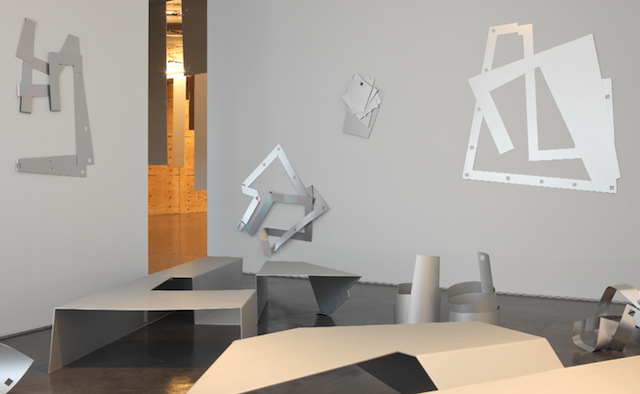Dirimart Dolapdere, Istanbul, 5 April – 14 May
It is impossible to avoid the digitally rendered posters of beautifully renovated apartments, featuring smiling families breakfasting on their balconies, draped over the seemingly endless scaffolding that props up Istanbul’s oldest districts. Unintentionally, they reflect the economic, political and social undercurrents that accompany urban regeneration in the city’s low-income areas. The posters are simultaneously a mirage (locals cannot afford the dwellings), a cover-up (‘improving the image of our city’ reads better than ‘rewarding party-loyal property developers’) and culturally tone-deaf to their environs – shabby urban neighbourhoods, perhaps once known for their merchants or artisans specialising in some now-defunct trade, like ship repairs. Gentrification is nothing new to cities. But in Istanbul – where heritage is aplenty, yet there are huge barriers to its protection, and building has boomed unchecked – its pace can create bewildering contrasts in architecture, lifestyle and income within one neighbourhood, and leave many of its equally bewildered communities behind.
Tears, fragments of concrete and plaster dust on the panels suggest violent removal
This context is crucial to Ayşe Erkmen’s current exhibition. That visitors travel through the dilapidated Dolapdere neighbourhood to reach the new, imposing glass building that houses Dirimart seems calculated: you pass construction sites for a second Arter gallery and the Koç Museum of Modern Art; showrooms for condos in progress; half-collapsed wooden houses seemingly uninhabitable yet crisscrossed with laundry. Erkmen designates the neighbourhood itself as the first of three ‘zones’ her show occupies, and it leaks inside as a sound installation looping throughout the main room (zone two) and a second, smaller room (zone three). A recording made during a walk from Pangaltı to Dolapdere – the artist reading local signage aloud – has been transformed into abstract frequencies then played back, bookending Erkmen’s otherwise site-specific sculptures with a broader sense of place.
The physical works within the second zone are in a flux that complements this nebulous sound installation. The gallery’s wood-and-plaster panelling has been torn away and suspended from the ceiling at varying heights. Tears, fragments of concrete and plaster dust on the panels suggest violent removal, while the exposed walls still hold the now-useless nails. Though pursuing similar themes, Kıpraşım Ripple is subtler than bangbangbang (2013): Erkmen’s lifesize crane and buoy suspended over a warehouse-turned-Istanbul-Biennial space then marked for demolition. This subtlety mirrors the slight retreat in Istanbul’s appetite for overt protest – for reasons of increasingly violent state response since July 2016’s coup attempt – and allows Erkmen to reflect on the role of private interests, like the art market’s, in this transformation. The restless, rippling effect these torn wall panels lend the white-cube space – weakening, both physically and conceptually, its perceived perfection – emphasises its shifting cultural currency, the physical brutality of construction and Erkmen’s own catch-22: an artist both profiting from utilising a space born of gentrification, and lamenting her hometown’s transformation. The third zone contains twisted and bent aluminium frames. Resembling the surplus building materials piled around the surrounding neighbourhood, these sculptures, recreated in shiny metal and then deformed, are attractive but flimsy: a parallel with those empty new-builds that hard-pressed locals are expected to applaud as progress for all.
the artist suggesting an answer to her own creation’s problematic, uncomfortable presence vis-à-vis her lamentation of urban transformation
Erkmen wants her works’ ephemerality emphasised, that’s clear. The site-specific works, all untitled, will be dismantled after the show to allow the walls to be repanelled, and stored by the gallery, useless for repeat exhibition due to Kıpraşım Ripple’s site- and temporal-specificity. This lack of anything to sell on is perhaps the more thought-provoking takeaway here, the artist suggesting an answer to her own creation’s problematic, uncomfortable presence vis-à-vis her lamentation of urban transformation. Thus she asks whether this is the intervention that matters in such a context: to minimise your footprint, and leave. But where market forces will fill the gap anyway, whether with a gallery or another condo, is it any better to withhold art? True, Erkmen extracts the value of having put on an exhibition, but the show being free of charge and the works having no continued existence in the same form makes an accusation of hypocrisy too facile. To dismiss the installation’s social comment by fixating on whether its ephemerality absolves the artist is inconsistent with her past oeuvre, and blind to the works’ communication of Istanbul’s urban situation. Erkmen articulates the latter here with a contextual awareness, timeliness and impact that displays the city’s socioeconomic tensions, simmering beneath those garish banners promising prosperity.
First published in the Summer 2017 issue of ArtReview
